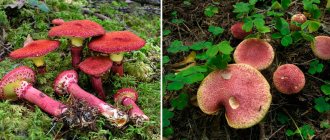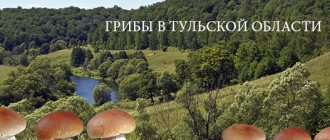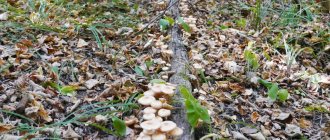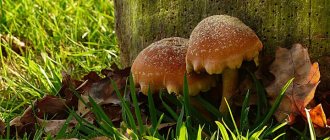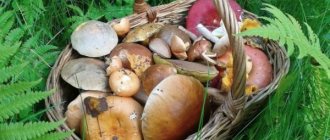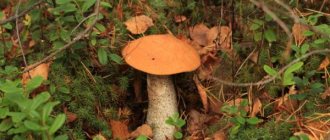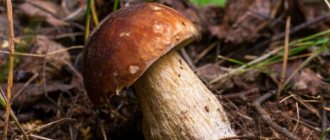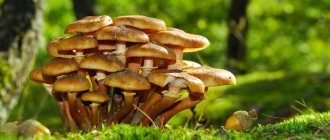Information on where to go for mushrooms in August 2022 in the Leningrad region.
Do you know what the forest smells like? It smells like air! The one you won’t find in the city during the day. It also smells like mushrooms. In season. Which is now, in fact, gaining momentum with might and main. Unfortunately, we do not have the opportunity to go mushroom picking every day, although we know where (this means not only the Leningrad region, but also Karelia, the Pskov region, and even Finland). Since childhood, I remember how early in the morning (more like late at night) I, half asleep, was put into a car, baskets and food were loaded into the trunk and taken somewhere far away. All day. Therefore, I know all the places where to go for mushrooms in the Leningrad region in late summer and autumn. And without regret we will now burn these places.
(The photo of the mushrooms was stolen from the Internet, because we collect mushrooms and forget to take pictures))))). If the owner is found, we will indicate his full name)
Mushroom places of the Kirov region
Otradnoe. Boletus mushrooms have just started growing there. They'll be out completely by next weekend. The information has been verified by friends.
Voitolovo and Sologubovka (about 50 km from the ring road). There is more than excellent forest there. It is also good because it has swamps where cranberries grow in the fall.
Sinyavino. A good mushroom place in the Leningrad region, but too popular. People travel here by train and by car. And there are plenty of local summer residents. So, if you are thinking about where to go for mushrooms and decide to go to this part of the Leningrad region, get up early.
In the opinion of our friends, the best mushroom place in the Kirov district of the Leningrad region is Lavrovo. A little further is Sinyavino, but there are no gardens here and, as a result, some mushroom pickers are swept away.
In June, the Leningrad region is rich in oyster mushrooms and puffballs
Oyster mushrooms are not small mushrooms. The fleshy, rounded cap, thin at the edges, has a diameter of 5 to 30 cm. Shell-shaped or close to a circle in shape, the surface is smooth and glossy. Young mushrooms have a humped cap. Later it becomes smooth or takes the form of a funnel, and its edge is wavy or in the form of blades. It may have a dark gray, brown, ash-gray-violet, faded whitish, gray or yellowish color. Oyster mushrooms have short, sometimes almost imperceptible, solid, cylindrical-shaped legs, narrowed at the base. When a mushroom ages, its stem becomes stiff.
Oyster mushrooms are eaten young, after removing the stem. Old mushrooms are unsuitable for eating due to their hardness.
The fruiting body of the raincoat is endowed with a closed structure. It has a round, pear-shaped shape and a small false stalk, which is clearly defined. The mushroom is covered with spiny outgrowths, which sometimes fall off as the mushroom ages. When the spores mature, a small hole appears at the top of the fruiting body.
Mushroom places of the Vyborg region
AHTUNG! August 2022 - boletus and boletus in large numbers in Kamenka at the training ground! Let's all go there! Well, chanterelles also climb there in large numbers.
The Vyborg region is rich in mushroom places. Kesha has a gardening dacha in the forest there, and sometimes as soon as you step outside the gate, you can find several “noble ones.” Therefore, often there is no question at all about “where to go for mushrooms in the Leningrad region” - we just go to the dacha. And we have a dacha in Yappilya.
5 km from Yappil, another famous mushroom place in the Vyborg region is Lake Zerkalnoe. That’s for sure, if you decide where to go for mushrooms in the Leningrad region so that you can return with a full basket, Zerkalnoe will be a win-win option.
Tank training ground Kamenka. There are a lot of mushrooms, but they shoot. Although they warn about shootings in advance.
Pervomayskoe. . Our favorite mushroom place in the Leningrad region. The day before yesterday we picked up a whole bucket of moss and boletus mushrooms while walking slowly and with the child. The child himself found the white ones and was terribly happy. And there are surprisingly a lot of blueberries and lingonberries.
Brief description of morels and boletus collected in June
Morels are spring-summer mushrooms growing in the forest, park and garden. Many of them appear three to four years after forest fires. There are fewer of them in areas of old fires, but they grow there every year. According to some reports, they are able to form mycorrhiza with some trees, for example with ash. However, there is no scientific confirmation of this theory.
Morels can be eaten boiled, as well as fried after boiling.
Morels are constantly confused with other mushrooms - strings, which are toxic in their raw form. They end up in the same container and from such proximity real morels also become toxic. Because of this, Russian sanitary doctors consider both strings and morels to be “relatively edible mushrooms.”
Butterflies are called so because they have a slippery and oily-looking cap. They differ from other members of the boletus family by the sticky, slimy, easily detachable skin on the cap and the ring left over from the blanket that previously covered the bottom of the cap. The hat is convex or flat. Hymenophore yellow or white. The flesh of butter mushrooms is whitish or yellowish, but if the mushroom is cut off, this place turns blue or red.
Edible species
The Luga region differs from other places in its stable harvests. All summer and autumn, these places delight lovers of “forest hunting” with a variety of types of “forest meat”.
Summer and group
The artillery range is famous for its huge variety of mushrooms. The most popular summer species include:
- oyster mushrooms;
- chanterelles;
- milk mushrooms;
- saffron milk caps.
At the end of spring, raincoats appear. On the soils of the landfill they grow quickly and reproduce in the deciduous part.
When the grass turns green, the first caps of summer honey mushrooms begin to appear; they bear fruit until October. They grow in groups, on stumps. It is better to cut off only the caps, they contain more vitamins and are tastier.
Oyster mushrooms can usually be found on tree trunks or stumps.
Boletus will delight its fans in mixed and pine forests. They hide under fallen leaves, in the shade of trees.
All types of whites appear closer to August. It is better to look for boletus mushrooms in larch thickets.
Autumn views
The best time to pick mushrooms is in September
At the Luga site it is better to pick mushrooms in early September, when it is still warm like summer. During this period, you can take porcini mushrooms and black milk mushrooms, saffron milk mushrooms, fly mushrooms, boletus mushrooms, autumn honey mushrooms and morels.
Sometimes on lawns you come across:
- Russula;
- greenfinches;
- boletus;
Popular mushrooms for pickling are valui; they belong to the Russula family and the group of conditionally edible mushrooms. They look attractive, but have an unpleasant taste and strong aroma.
Where to look for mushrooms in the Leningrad region in 2020
Experienced mushroom pickers do not walk through the forest at random, but go only to those places where, according to experience, a certain type of mushroom is found. Beginners often cannot reap a rich harvest, not only because edible species are skillfully camouflaged under fallen leaves and pine needles, but also because they do not know the places where boletus, boletus or other forest “inhabitants” are found.
To make your task easier, here is a list of the best areas for picking mushrooms in the Leningrad region. Using our tips, you can choose the best place for a “quiet hunt”, depending on your personal preferences or place of residence.
Lyudeynopolsky district
In the Lyudeinopolsky district there is the village of Alekhovshchina, which is traditionally considered one of the best mushroom places in the region. Near this village there are many deciduous forests, in which chanterelles, moss mushrooms and boletus mushrooms are often found (Figure 1).
Real edible chanterelles are easy to identify: they grow in large families, and the edges of the cap are uneven. In addition, in edible chanterelles the color of the fruiting body ranges from yellow to orange, while in false chanterelles it is brighter and more saturated.
Figure 1. The most common species of the Lyudenopolsky district of the Leningrad region: chanterelles, moss mushrooms and boletus mushrooms
Also in the Lyudeynopolsky district there are moss mushrooms - tubular species with a gray-green or olive cap. It is slightly velvety to the touch, and when cut, the flesh acquires a bluish tint. The caps of adult specimens often crack, which spoils their appearance, but does not at all affect their taste. In addition, common boletus, multicolored boletus, and marsh boletus are often found in this region. All these species are edible, but the marsh species is listed in the Red Book, so collecting it is not recommended. The boletus cap, depending on the type and place of growth, can have a shade from off-white to dark brown. In damp or rainy weather, the surface of the cap becomes slippery. Boletus mushrooms grow very quickly: in just one day, one specimen can increase by 4-6 cm. For this reason, boletus mushrooms are often damaged by animals and insects. On the one hand, this is a minus, because mushrooms lose their attractive appearance. On the other hand, you can safely collect such damaged specimens without fear that you will confuse the boletus mushroom with an inedible gall fungus.
Kirovsky district
Another popular area is Kirovsky. Despite the fact that many species of these forest inhabitants are found here, they most often go here for bitterweeds and honeydew (Figure 2).
Note: In the Kirov region there are many pine forests and mixed forests, which serve as habitat for these species.
Bitterbush belongs to the lamellar species that prefer to grow in coniferous forests, birch groves and other areas with high humidity. It is worth noting that bitter mushrooms are classified as conditionally edible mushrooms, since their pulp has a pronounced bitter taste (hence the name), which disappears only after proper heat treatment.
Figure 2. Forest inhabitants of the Kirov region: bitterlings and podgruzdi
Since bitterberries are a lamellar species that can easily be confused with poisonous ones, when going into the forest, you need to know how to distinguish an edible specimen from an inedible one.
Bittersweet has the following characteristic features:
- The pulp is dense, and in young specimens it is colored with white pigment.
- A distinctive feature is that the pulp secretes a watery white juice. It is very hot and pungent in taste, but has a pleasant woody aroma.
- Under the cap there are plates that are located often and with minimal clearance. At the same time, they are extremely fragile and brittle.
The average length of the stem does not exceed 11 cm, and its diameter is about 3 cm. The diameter of the cap can reach 10 cm, but it is recommended to collect only young specimens, since radionuclides can accumulate in old ones.
Another mushroom that is found in the Kirov region is podgrudok. Outwardly, it is similar to ordinary milk mushrooms, but lacks a fringed covering along the edge of the cap. Under it there are frequent white or bluish plates. It can grow not only in coniferous, but also in deciduous forests, and is perfectly camouflaged under foliage. It is noteworthy that not all mushroom pickers collect milk mushrooms and milk mushrooms, since they require special heat treatment before salting, pickling or cooking.
Volkhovsky district
The Volkhov district is also considered a very popular place among mushroom pickers. In addition to the most common species, such as boletus, chanterelles and honey mushrooms, gray boletus is often found in this area.
What to take for mushroom picking?
Everything is simpler with mushrooms. To collect, you only need a basket and a knife. You don’t have to use a knife and just twist the mushrooms, but it’s better to put them clean.
“Cutting or twisting a mushroom is for convenience. But you need to put a mushroom clean of dirt into the basket. Then it will be easier to process your harvest. There are now mushroom picker knives on sale: on one side there is a blade, and on the other there is a hard brush,” shared the mushroom picker.
An experienced mushroom picker also advises taking a stick with you. It will help move the foliage, and for safety.
It is better not to collect mushrooms in a plastic bag - they quickly suffocate. At elevated temperatures, pathogenic processes develop faster in mushrooms, and mushrooms can deteriorate and become poisonous. Instead of a basket, you can use a bucket or canvas bags, as well as collapsible baskets.
pxhere.com/
Neighborhood
The entire area of the test site is picturesque, with many high hills. Here, vast areas are occupied by pine forests, with white mosses and sandy ridges. In the forest there are many birds, unusually beautiful grasses and sandy ridges. There are several small lakes in the territory, but also many swamps.
This area is relatively deserted and clean. If you drive in from Luga, there is a barrier with a soldier in front of the entrance to the training ground. However, from Serebryansky you can easily enter the territory.


